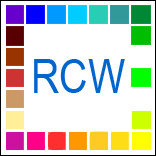Viridian Green, it's made synthetically and includes black pigment which I stay away from.
Another pigment I stay away from is Naples yellow in watercolor, it dries darker instead of lighter like the rest of watercolors. White dries darker also. I made some white last year that included some lime white with the titanium white. The reason was I wanted a white to block out color, not to mix with them. The lime neutral pigment has bigger grit and doesn't sink into the paper like titanium or zink does.
There are two other colors that left my palette early on. Payne's Gray in watercolors sticks out wherever it's used. The other is an oil paint, a light off yellow called Gamboge. I limit my palette to colors I can use often, gamboge won't make it as the yellow, it won't get brighter and wherever it used it sticks out, here is a page on the last time I used that color.
http://www.realcolorwheel.com/paintingknife.htmThe original gum gamboge was the color of earwax, clear and you could lighten it, but not brighten it. Indian yellow brown side replaced it. In 1899 Indian yellow was politically dropped. Old holland made a synthetic at that time from the element Nickel. The colors were good and matched the cow urine colors orange and brown. We didn't have the internet back then and the world never knew it was available so it stayed on the shelf all through the wars. After the wars colors were made of petroleum and there were no transparents colors. Art was at ground zero. Loud artists like Picasso got the attention, there were no good artists left. Courbet was the last to leave France, the bad artists were taking over.
I just posted a re-make of the page I hope you visit. All about Color.
http://www.realcolorwheel.com/final.htmIt took years to write, more years to transcribe to the computer and the last two months setting up the index. It's not completely done but it's workable.

 Home
Home

 Help
Help

 Search
Search

 Login
Login

 Register
Register

 Broadcast Message to Admin(s)
Broadcast Message to Admin(s)

 « Home
« Home  ‹ Board
‹ Board  Top of this page
Top of this page 
 Pages: 1
Pages: 1

